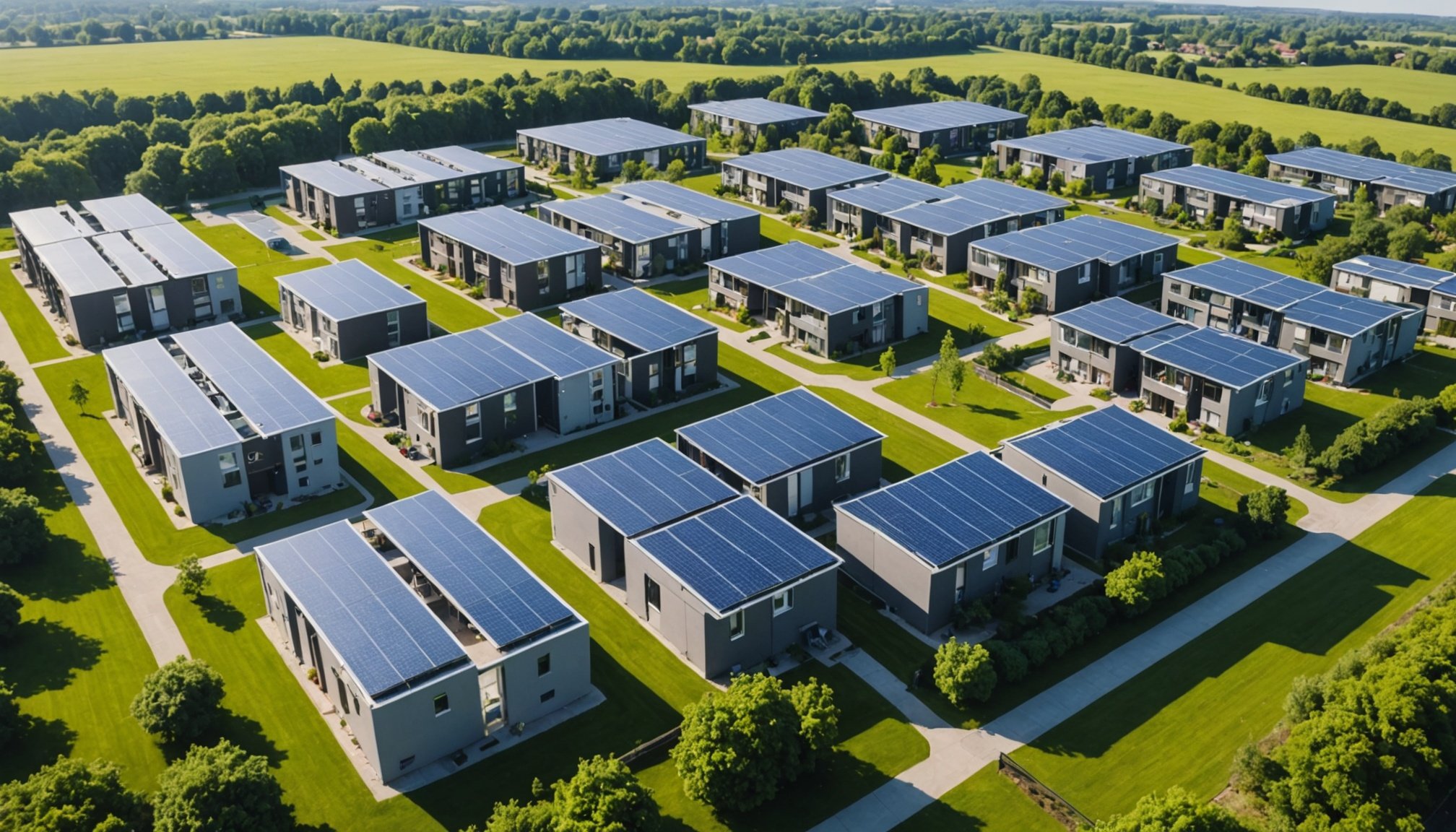Overview of Renewable Energy in Housing Developments
Renewable energy is a crucial component of sustainable design in today’s housing developments. It refers to energy derived from natural sources that are replenished at a higher rate than they are consumed. This includes solar, wind, and geothermal power. These sources play a significant role in reducing reliance on fossil fuels and in lowering the carbon footprint of housing developments.
In the context of housing, renewable energy is not just about integrating technology but adopting a holistic design approach. Large-scale housing developments are increasingly shifting towards sustainable design, with renewable energy as a pillar. Current trends showcase the adoption of technologies like solar panels, wind turbines, and geothermal heating. These innovations are not only about energy generation but also about creating a sustainable environment for living.
Furthermore, incorporating renewable energy sources into housing projects has economic, environmental, and social benefits. They reduce energy costs over time, decrease greenhouse gas emissions, and foster a greater sense of community and awareness about environmental issues. Understanding these benefits is essential for developers, architects, and residents alike.
Benefits of Integrating Renewable Energy
Integrating renewable energy into sustainable housing developments offers a multitude of advantages. One of the foremost environmental benefits is the reduction of carbon footprint, a result of decreased reliance on fossil fuels. This transition aids in mitigating climate change and promoting healthier living surroundings.
In parallel : Protecting Coastal Cliffs in UK Towns: Key Strategies for Assessment and Safety
Economically, integrating renewable energy systems into housing leads to significant cost savings over time. Not only do homeowners benefit from reduced energy bills, but numerous incentives and subsidies are often available. Governments provide financial support through grants and tax benefits to encourage the adoption of renewable technologies, making initial investments more manageable.
The social impacts are equally profound. Renewable energy integration fosters community well-being by generating awareness of environmental issues and encouraging a collaborative spirit in tackling these challenges together. Housing developments that prioritise sustainability often witness a stronger sense of community amongst residents. Additionally, these communities inspire more profound understanding and education around energy use, contributing to a more eco-conscious society. By encompassing environmental, economic, and social dimensions, the integration of renewable energy in housing developments enhances the quality of life for current and future generations.
Implementation Strategies for Renewable Energy Solutions
Implementing renewable energy solutions in housing projects involves meticulous planning to ensure effectiveness and sustainability. Initiating these projects requires feasibility studies to assess site conditions, potential energy yields, and financial viability. Engaging stakeholders such as developers, architects, and local communities early in this phase fosters cooperation and smooths regulatory pathways.
Project Planning and Feasibility
At the project’s inception, conducting detailed environmental impact assessments clarifies the potential for harnessing solar, wind, or geothermal energies. Feasibility studies, including energy audits and cost-benefit analyses, guide developers in understanding both opportunities and limitations.
Selecting Suitable Renewable Energy Technologies
The success of implementation strategies also hinges on choosing suitable technologies. Criteria such as local climate, topography, and infrastructure determine whether solar panels, wind turbines, or geothermal systems are optimal. Tailoring technology to the specific environment maximises efficiency.
Collaboration Among Stakeholders
Lastly, effective collaboration among all stakeholders is paramount. Establishing clear communication channels ensures that developers, architects, and residents work towards common goals. Understanding diverse perspectives encourages innovation and community-driven solutions, ultimately leading to more holistic and sustainable renewable energy adoption in housing projects.
Challenges in Harnessing Renewable Energy
Renewable energy use in housing developments encounters several challenges. One primary concern is the technical aspect. Integrating renewable technologies with existing energy grids can be complex due to fluctuating energy supplies from sources like wind and solar. Ensuring technology reliability to provide a consistent energy output is also crucial, as unpredictable power supply can lead to inefficiencies.
Financial hurdles add another layer of complexity. The initial upfront costs for deploying renewable energy systems can be formidable, despite long-term benefits. Securing funding sources often involves navigating through various financing options, which can be daunting for developers focused on sustainable housing.
On the regulatory front, housing projects face numerous barriers. Local policies may impose strict regulations and requirements, which can delay project timelines and increase costs. Navigating these regulatory landscapes necessitates a thorough understanding of both national and local policies impacting renewable energy use.
Overcoming these challenges requires creative solutions, such as leveraging financial incentives and working with policymakers to create a more supportive framework for renewable energy integration in housing developments.
Best Practices for Sustainable Energy Integration
Implementing sustainable energy solutions in housing can be challenging, yet certain best practices enhance success. Thorough case studies of successful housing developments reveal how carefully planned projects thrive. These examples provide insights into innovative practices and proven strategies, underscoring the importance of tailored approaches to unique environmental and social contexts.
Design Principles for Energy Efficiency
Key principles, such as optimising building orientation and incorporating passive solar design, are vital. Using energy-efficient materials and technologies, in combination with renewable sources like solar and wind, maximises benefits. Integrating advanced insulation, efficient windows, and natural lighting reduces energy demands significantly, proving essential for sustainable design.
Monitoring and Maintenance Strategies
For long-term success, ongoing monitoring and adaptive maintenance are critical. Regular assessments ensure systems operate efficiently, and timely upgrades can incorporate emerging technologies. Establishing robust maintenance protocols guarantees the longevity and efficacy of these energy systems, ultimately leading to reduced costs and enhanced sustainability.
By adopting these best practices, housing developments achieve sustainable energy integration effectively. Moreover, these practices enhance overall community well-being, demonstrating the importance of a proactive and informed approach to renewable energy incorporation.
Regulatory Considerations and Incentives
Navigating regulations and incentives is integral to advancing renewable energy in housing developments. Understanding the regulatory landscape helps developers align with policies and take advantage of benefits offered. Regulations can vary widely, impacting what energy solutions are feasible in certain locales. Adhering to these laws can ensure smoother integration and operation of renewable systems.
An overview of relevant regulations reveals that they often focus on building codes, energy efficiency standards, and environmental protection. Knowledge of these frameworks aids developers in crafting projects that comply with laws while maximising environmental benefits.
Incentives play a crucial role in adoption by easing the financial burden. These can include tax credits, rebates, and grants aimed at fostering sustainable construction. By leveraging these incentives, developers can reduce initial costs, making projects more economically viable.
Government policies significantly influence renewable energy adoption. Proactive policies can drive innovation by supporting research and development. They also encourage community engagement initiatives that further enhance the appeal and effectiveness of sustainable housing.
Overall, aligning with regulatory considerations and tapping into the available incentives is vital. This approach fosters a supportive environment, driving the successful integration of renewable energy within housing developments.
Future Trends in Renewable Energy for Housing
Embracing future trends in renewable energy is pivotal for the evolving housing industry. As technology advances, new possibilities in energy solutions are emerging. Solar energy innovations, like advanced photovoltaic cells, promise to boost efficiency even in less sunny environments, while wind power sees improvements in turbine design, making them more viable for urban settings.
Energy storage systems, such as lithium-ion batteries, are becoming more efficient and affordable, allowing excess renewable energy to be stored for later use. This advancement mitigates intermittent energy supply issues associated with solar and wind, enhancing energy reliability for housing developments.
Regulatory frameworks are expected to shift, encouraging sustainable practices further. Policies favouring eco-friendly construction are likely to become more stringent, pushing the housing industry towards innovative solutions. Future incentives may focus more on community-driven renewable projects, empowering local groups to spearhead sustainability initiatives.
Community initiatives will play a significant role, with residents increasingly participating in co-operative energy schemes. These programs not only support green energy adoption but also foster a sense of ownership and collective responsibility towards environmental conservation. By staying ahead of these trends, housing developments can align with a sustainable future.








